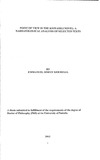| dc.description.abstract | This study entailed analysis of the rendering of point of view and the meaning of such
, rendering in selected Kiswahili novels. The analysis covered four planes of point of view
(phraseological, ideological, perceptual and psychological) as well as the two main types of
point view (internal and external). The analysis was guided by narratology, a theory that explores how narration functions. Methods employed in carrying out the research were: interpretation, analysis and conceptualization. All were based on the qualitative research approach. Non-probability sampling design was used to identify material for analysis. Samples were selected from the texts based on degree of intensity and richness in expressing specific aspects of point of view as well as how typical the samples are in describing point of view. Intensity and typical case sampling techniques proved productive in establishing the excerpts used for analysis in order ~> to-have manageable data.
The work is organised in chapters with each chapter dealing with one aspect of point of view.
After the introductory chapter, the analysis moves to exploring the concept of point of view
which sets the framework for the analysis in subsequent chapters. Consequently, the phraseological, ideological, perceptual and psychological planes of point of view are
analysed. Finally, the two main types of point of view - internal and extemal- are analysed.
The study established that in Kiswahili novels point of view is rendered differently by
different writers.
All aspects of point of view envisaged are present in Kiswahili novels. However, some are accorded more emphasis than others by different writers. Most novels are conducted in the external point of view which allows ease in expression of ideas and thoughts. A few novels are conducted using the internal point of view. Some writers have been creative and have used both the internal and external point of view side by side. Such an effort pushes creativity in rendering of Kiswahili novels to a higher level instead of depending on the traditional methods of presentation.
Although the perceptual plane is quite pervasive in Kiswahili novels, the study shows that unless markers of space and time are used artistically to clearly express point of view, they end up remaining just as endophoric and temporal markers. It was also established from the analysis that the psychological point of view is equally pervasive in Kiswahili novels. The phraseological plane is less pervasive compared to the other two planes. It was established that only some writers use this plane widely.
The ideological plane is present in novels though with less pervasiveness. By definition, it is a plane that needs space and time to clearly anchor it in a novel. Since this plane of point of view is hidden beneath the ideas and thoughts of the narrator and characters, the analyst ends up using own intuition to uncover it. It was also evident that there is an overlap of the various planes of point of view. For instance the same markers of phraseology also carry psychological and ideological points of view.
Naming is a good case in point. In applying point of view, writers enhance the narrative meaning of their works. It is not just a narrative device for embellishing art but is employed to effectively capture the intended meaning as well as project attitudes, judgments, perspectives and positions. Point of view affects social relationships among individuals either positively or negatively. | en_US |

